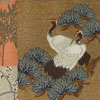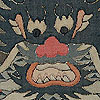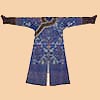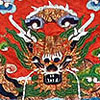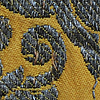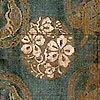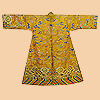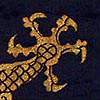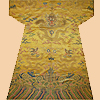 |
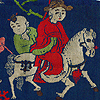
1907 & 1908
Antique Chinese Ming Textile.Silk Brocade with Gold Thread
Qing Dynasty
Circa 1680
Size 24" x 15"
Size 61 x 38cm
Top and Below are Detail Images
We have two panel
Size 28" x 15"
Size 71 x 38cm
More Information Below
Asian Textile History

|
 Chinese Ming Imperial Textile
Chinese Ming Imperial Textile

Chinese Imperial Clothing
Nanjing Yunjin
Nanjing Yunjin,or Nanjing Brocade, is soft and lovely as the clouds, more valuable than gold.
Nanjing Yunjin refers to the incredibly beautiful brocade made in Nanjing, capital city of eastern Jiangsu Province. Yunin Chinese means clouds, and jinmeans brocade. The image is lovely: A delicate and flossy piece of brocade that feels just like soft clouds. 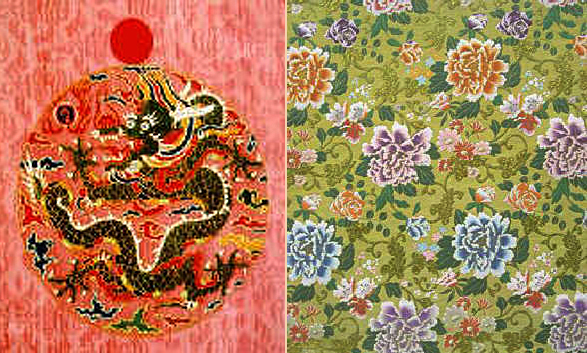
Later in the Yuan Dynasty(1279-1368), Mongolians conquered Central China and the rulers then defined a tradition of decorating officer's dress with shining gold and silver. With the flourishing and exploitation of gold mines, weavers added real gold thread into Nanjing brocade. The shining brocade immediately won great favor of feudal kings and aristocrats and also was popular among ethnic minorities such as Mongolians, Tibetans and Uygurs. In the Yuan, Ming (1368-1644) and Qing (1644-1911) dynasties, rulers set up official special fabrics bureaus in Nanjing for the administration and monopoly of the brocade production and marketing. They listed it as one of the special royal tributes to emperors. Brocade technology was repeatedly refined despite high costs both in terms of time consumed and materials used. It was not long before the brocade surpassed the other famous silk products, and it obtained fame as a silk fabric with the greatest rarity and high technology.
In the middle of the Qing Dynasty, the boom in the production of the brocade reached its climax. In the numerous fabrics trading households along the Qinhuai River in Nanjing, weaving could be heard as it echoed day and night and an unprecedented outcome in brocade production was enjoyed. Records say that more than 30,000 looms were involved in brocade production and 300,000 people made a living on it.

Brocade protection
An inch of the Nanjing brocade was said to be as valuable as an ounce of gold. What is interesting is that the delicate and soft brocade came out from wooden looms as big as 5.6-meters long, 4-meters high and 1.4-meters wide. The huge looms needed two operators, one above and one below in the delicate production sequence that was as complicated as a current computer programming language. The process showed the incredible talent of Chinese of the past.
The person sitting at the loom was known as a "thread puller". All he or she had to do was to pull the thread in line in the threading sequence, corresponding to commands entered into a computer keyboard of today. The person sitting on the lower part of the loom was called a "weaver". He or she twined the pattern and wove the materials into brocade using golden or multi colored threads. The woven piece in front of the weaver was just like a computer screen. The weaving technology of the brocade is exceedingly complex and exquisite, and no modern machine has yet been able to replace the ancient looms.
There are mainly four categories in brocade: gold weaving, (in which gold is pressed into foil, then cut into thread-like pieces to be twisted into threads and then woven on looms) Ku Silk Fabrics, Ku Brocade Fabrics and Zhuanghua Silk Fabrics. All four categories serve as materials for emperors' robes, queens' dresses and shawls, concubine's clothing, decorations for the imperial courts and daily use articles, including cushions, mattresses, pillows, and quilts. The Nanjing brocade served as precious gifts for emperors to give to foreign kings and ministers.
The Chinese government has spent some 10 million RMB in the protection and repair of Nanjing Yunjin. The Nanjing Brocade Research Institute has undertaken an in-depth study and rectification of the historical archives and successfully copied one of the most outstanding silks in the Mawangdui Han Tomb. The 1.28-meter-long silk coat with a pair of long sleeves is as light as the mist and as fine as gossamer, weighing a mere 49 grams. The institute has also published 200 volumes on brocade objects and the most comprehensive monograph on the history of the art's development. It is called the Chronicle of Brocade.
Imperial robe. three sets of clothing: regular, court and ceremonial. Imperial clothes were made with silk, gold, sliver, pearls, jade, rubies, sapphires, coral, lapis lazuli, turquoise, agate, various kind of fragrant woods, kingfisher feathers and thread made from peacock feathers. Beginning in the Sui dynasty (581-618 A.D.) the emperor appropriated the color yellow and prohibited other people from wearing it based on a purported precedent set by the legendary Yellow Emperor. Imperial clothing accessories included belts, ceremonial hats, regular hats, hairpins, headdress ornaments, bracelets, thumb rings, fragrance pouches, purses, watches, rosaries, belts (regular, court and ceremonial), necklaces hat finials, hat decorations, silk purses, shoes for bound feet, hats withes jeweled knobs, headbands, silk kerchiefs, fans, rings, buttons, hooks, earnings, brooches and fingernail guards. Robes were the most visible and decorated garments. They were usually made of silk and featured lavish colors, exquisite stitching and a variety of embroidered decorations and symbols. Most pieces that remain today date to the Qing Dynasty (1644-1911). The Qing's (Manchu's) were horse people and many of their garments were designed for riding on horses. Many robes have long horseshoe-shaped cuffs because it was considered impolite to show one?s hands and fingers. Symbols on Chinese Imperial Clothing Embroidered dragons on an Imperial robe During the Qing dynasty the ranks of courtiers and bureaucrats were indicated by decorative designs on their costumes, the number of peacock feathers on their hats and the number of precious materials they were allowed to wear. For example, the formal over-robe worn by a first degree civil servant was embroidered with a crane while that of a second degree civil servant was embroidered with a golden pheasant. Robes of lower ranking officials were decorated with other animals. Color also indicated rank. Brilliant yellow was reserved for the Emperor. Muted yellows were worn by his underlings. Beginning in 1759, emperors were required to wear 12 symbols of authority that included dragons, stars and symbols representing the ocean. The lower portion of a jacket often contained diagonal stripes signifying water and rolling waves, mountain peaks symbolizing the earth and mountains and dragons in the clouds representing air. At the neck was a gate to heaven. Fancy robes had nine dragons, an auspicious numbers, symbolizing power and virility.
| |
|
 |
|

